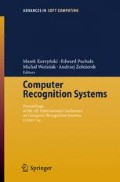Abstract
There are considered the role and applications of ontological models in advanced pattern recognition methods. Formal definition of ontological models, a general taxonomy, and specification of some typical ontological models are presented. Examples of a simple, a composite and an extended ontological model are given. The role of ontological models in composite patterns recognition is described and illustrated by examples.
Access this chapter
Tax calculation will be finalised at checkout
Purchases are for personal use only
Preview
Unable to display preview. Download preview PDF.
References
Peterson WW, Birdsall TG, Fox WC (1954) The theory of signal detectability, Trans. IRE, PGIT-4: 171–212
Rosenblatt F (1958) The perceptron, a probabilistic model for information storage and organization in the brain. Psychol Rev 68
Fernandez-Lopez M, Gomez-Perez A (2002) Overview and analysis of methodologies for building ontologies. The Knowledge Eng Rev 17(2): 129–156
Gruber TR (1993) A translation approach to portable ontologies. Knowledge Acquisition 5(2): 199–220
Kulikowski J.L. (1972) Cybernetic recognizing systems. PWN, Warsaw (in Polish).
Corcho O., Gomez-Perez A. (2000) Evaluating knowledge representation and reasoning capabilities of ontology specification languages. Proc. of the ECAI 2000 Workshop on Application of Ontologies and Problem Solving Methods.
Wingert F. (1997) SNOMED a systemized medical nomenclature. Using manual. IBIB PAN, Warsaw (in Polish, translated from German).
Kurzynski M. (1997) Pattern recognition. Statistical methods. OWPW, Wroclaw (in Polish).
Fu K.S. (1974) Syntactic methods in pattern recognition. Academic Press, New York.
Tadeusiewicz R., Flasinski M. (1991) Pattern recognition. PWN, Warsaw (in Polish).
Kulikowski J. (1971) Algebraic methods in pattern recognition. CISM, Courses and Lectures No 85. Springer Verlag, Wien.
Kulikowski J.L. (1992) Relational approach to structural analysis of images. Machine Graphics and Vision 1(1/2): 299–309.
Schlenoff C., Balakirsky S., Uschold M., Provine R., Smith S. (2004) Using ontologies to aid navigation planning in autonomous vehicles. The Knowledge Eng. Rev. 18(3): 243–255.
Author information
Authors and Affiliations
Editor information
Editors and Affiliations
Rights and permissions
Copyright information
© 2005 Springer-Verlag Berlin Heidelberg
About this paper
Cite this paper
Kulikowski, J.L. (2005). The Role of Ontological Models in Pattern Recognition. In: Kurzyński, M., Puchała, E., Woźniak, M., żołnierek, A. (eds) Computer Recognition Systems. Advances in Soft Computing, vol 30. Springer, Berlin, Heidelberg. https://doi.org/10.1007/3-540-32390-2_4
Download citation
DOI: https://doi.org/10.1007/3-540-32390-2_4
Publisher Name: Springer, Berlin, Heidelberg
Print ISBN: 978-3-540-25054-8
Online ISBN: 978-3-540-32390-7
eBook Packages: EngineeringEngineering (R0)

